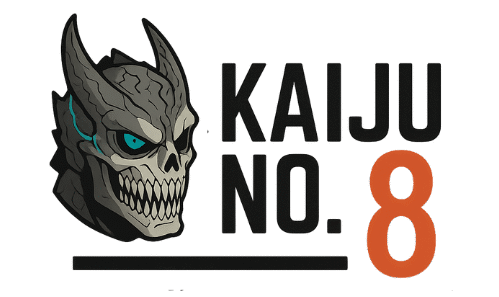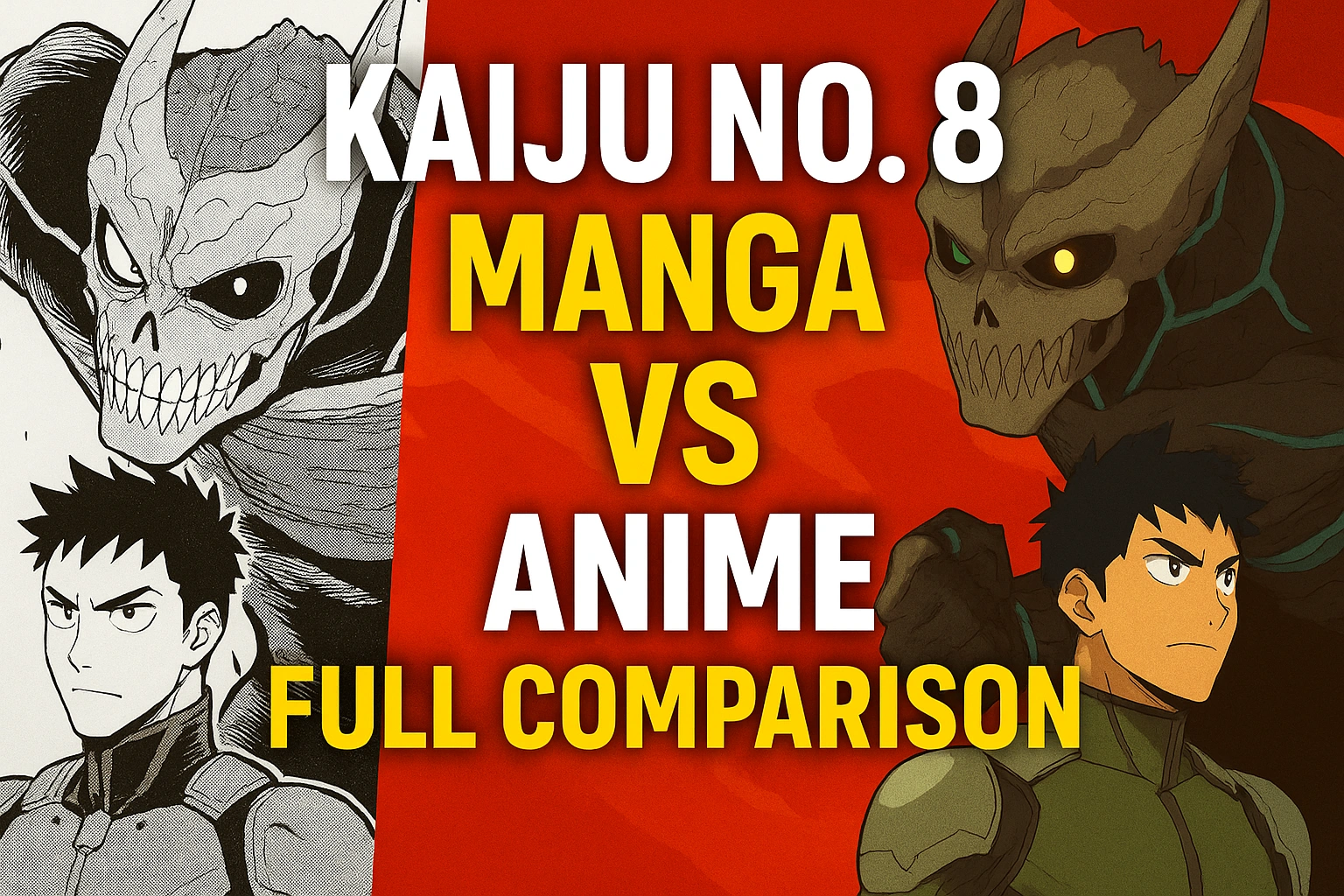Kaiju No. 8 is one of the most influential modern titles in the science fiction and monster-themed anime genre. With its rapid success as a manga and its high-quality anime adaptation, fans of the series are constantly comparing the two formats to determine which better captures the spirit and depth of the story. Both mediums bring their own strengths and nuances to the table. This detailed comparison will examine the differences and similarities between the Kaiju No. 8 manga and anime, covering areas such as plot adaptation, pacing, character development, visual style, emotional tone, world-building, and audience reception.
Whether you’re a manga purist, an anime enthusiast, or someone discovering the series for the first time, this guide will help you understand how the manga and anime versions of Kaiju No. 8 differ and where each one excels. You should also know that Kaiju No. 8 Amine Season 2 is going to be released in June.
Story and Plot Adaptation
Faithfulness to the Source Material
The Kaiju No. 8 anime stays largely faithful to the manga in terms of major plot points and story arcs. Key events such as Kafka Hibino’s transformation into a kaiju, his efforts to join the Defense Force, and his growing conflict with the kaiju threat are preserved. However, some minor elements are either condensed or rearranged to improve pacing for television.
Structural Adjustments
In order to fit into a season format, the anime occasionally shifts the order of scenes or simplifies complex sequences. Flashbacks in the manga are often given more breathing room, while the anime tends to integrate them directly into ongoing scenes for smoother flow.
These adjustments are not significant enough to change the core narrative, but they do impact how certain character motivations and world elements are introduced.
Pacing and Episode Structure
Manga Pacing
The manga provides a more deliberate and measured pace. Readers can linger on dramatic panels and digest the story at their own speed. Complex themes such as identity, loyalty, and fear are explored gradually across multiple chapters.
Anime Pacing
The anime compresses several manga chapters into single episodes, especially during high-action sequences. This creates a faster-paced experience that suits the medium but can feel rushed compared to the source. Some emotional beats are shortened, making them less impactful.
However, the anime uses animation techniques such as slow motion and music cues to simulate the introspective moments that are more easily conveyed in print.
Visual Presentation
Manga Art Style
The manga’s art, created by Naoya Matsumoto, is known for its sharp linework, expressive faces, and detailed kaiju designs. The black-and-white format allows for strong contrast between light and shadow, which is particularly effective in horror and suspense scenes.
Every panel is carefully composed, with a cinematic approach that guides the reader’s eye and builds tension. Battle scenes are visually dense, often requiring multiple reads to absorb all the detail.
Anime Visuals
The anime brings Kaiju No. 8 to life with color, motion, and sound. The animation captures the design elements of the manga while enhancing them with fluid motion, lighting effects, and environmental immersion. The kaiju look more menacing when animated, and action scenes benefit from dynamic camera angles.
Certain characters, like Kafka and Kikoru, gain additional personality through animation, especially through subtle facial expressions and voice acting that are not present in the manga.
Sound and Music
One of the most obvious differences between the two formats is the presence of sound in the anime. The original soundtrack elevates dramatic scenes and brings a sense of urgency and tension that enhances viewer engagement. Explosions, creature roars, and atmospheric sounds add realism to the kaiju battles.
Voice acting also plays a key role. Emotional depth is enhanced by skilled performances from the voice actors, particularly in scenes of transformation, despair, and personal conflict. The manga, by contrast, relies on visual cues and dialogue to convey emotion, which can be equally powerful but is more dependent on the reader’s interpretation.
Character Development
Kafka Hibino
In the manga, Kafka’s internal struggles are given more focus through internal monologue and slower pacing. His fear of losing his humanity, his guilt over past failures, and his motivation to become a protector are carefully unpacked.
The anime retains these elements but conveys them through animation cues like tone of voice, physical posture, and expression. Some subtle moments from the manga are lost, but new visual storytelling methods compensate for this loss.
Kikoru Shinomiya
Kikoru is portrayed as a prodigious and emotionally complex fighter in both versions. The manga offers more background through flashbacks, especially her relationship with her parents and her drive to surpass them.
The anime compresses some of this but emphasizes her growth through visual transformation and interaction with Kafka. Her development feels more immediate due to performance and pacing.
Soshiro Hoshina and Supporting Cast
Supporting characters like Hoshina receive deeper side stories in the manga, often via inner thoughts and chapter interludes. The anime focuses more on their actions and how they contribute to Kafka’s journey. This difference shifts the viewer’s attention to group dynamics rather than personal backstories.
Action and Fight Sequences
Manga Fights
In the manga, action sequences are dense with visual information. Every punch, blast, and transformation is detailed in multiple panels, often accompanied by sound-effect text and emotional close-ups.
This creates an immersive experience, though sometimes the intensity can become overwhelming without the benefit of motion.
Anime Fights
The anime’s battles are kinetic, fluid, and dramatically choreographed. Flashy visuals, fast cuts, and epic sound design make each fight a spectacle. Key moments are highlighted using slow motion, zoom-ins, and shifting perspective. These tools help simplify the action without losing intensity.
Some manga readers may feel that the anime sacrifices complexity for visual clarity, but the trade-off often works to enhance engagement.
Themes and Symbolism
Both the manga and anime emphasize themes such as transformation, duty, fear, and sacrifice. However, the manga tends to explore these themes through layered narration and symbolic imagery. Kafka’s transformation is not just physical but metaphorical, representing his inner journey from failure to responsibility.
The anime, while addressing the same themes, uses visual storytelling and music to guide interpretation. Some symbolic details are omitted or simplified for clarity. This makes the anime more accessible but slightly less nuanced.
World-Building and Lore
The manga offers a more in-depth look at the world of Kaiju No. 8. Readers learn about the history of the Defense Force, kaiju classification, weapon systems, and political hierarchies through detailed dialogue and supplemental chapters.
In the anime, some of these elements are introduced visually or through brief exposition. While the world remains intriguing, its complexity is somewhat reduced to keep the pace steady.
Original Anime Content vs. Manga Exclusives
So far, the anime adaptation of Kaiju No. 8 has not introduced any major anime-original arcs. However, certain scenes are extended or adjusted to better suit the animated format. Conversely, some short manga-exclusive moments, such as side stories or character-focused scenes, are absent from the anime.
This difference may widen in future seasons if the anime begins to diverge or expand beyond the manga’s original content.
Audience Experience and Accessibility
Manga Readers
Reading the manga offers a deeper and more introspective experience. Fans who enjoy analyzing character development, thematic depth, and artwork will find the manga more rewarding. However, it requires more effort and attention to fully appreciate.
Anime Viewers
The anime offers an immersive and cinematic experience, ideal for casual viewers or newcomers. Its high production quality, compelling voice work, and polished action scenes make it easy to engage with. However, some complexity and detail are lost in the transition.
Cultural Presentation and Localization
Localization choices can differ between manga and anime. Subtleties in translation, name pronunciation, or cultural references may be adapted differently. The anime sometimes simplifies terminology for broader international understanding, while the manga preserves more original phrasing.
This can affect how non-Japanese audiences perceive character motivations or cultural norms, especially when it comes to themes like honor, obedience, and self-sacrifice.
Overall Strengths and Weaknesses
Manga Strengths
- Deep character introspection
- Rich world-building
- Detailed artwork
- Slow, thoughtful pacing
Manga Weaknesses
- No sound or color
- Requires active interpretation
- Some action scenes may feel overwhelming
Anime Strengths
- Voice acting and music enhance emotion
- Color and animation bring visual appeal
- Fast-paced and accessible
- Strong production quality
Anime Weaknesses
- Some content is condensed or omitted
- Less room for subtle character development
- World-building details are simplified
Conclusion
Kaiju No. 8’s manga and anime both succeed in telling a compelling and emotionally resonant story, but they do so through different tools and creative methods. The manga offers depth, nuance, and a slow-burn experience that rewards careful reading. The anime provides a polished, fast-moving, and visually stimulating interpretation of the same story.
Choosing between the two depends on personal preference. For those seeking emotional depth and world complexity, the manga is ideal. For those looking for visual impact and immersive storytelling, the anime offers a satisfying experience. Ultimately, experiencing both provides the most complete understanding of the Kaiju No. 8 universe.
Frequently Asked Questions
Is the Kaiju No. 8 anime faithful to the manga?
Yes, the anime follows the manga’s storyline closely, with only minor adjustments for pacing and presentation. Key events and character arcs remain intact.
Which version should I start with: manga or anime?
If you prefer in-depth character exploration and storytelling, start with the manga. If you enjoy fast-paced visuals and cinematic action, the anime is a great entry point.
Are there scenes in the manga not shown in the anime?
Yes, the manga contains some exclusive scenes, character backstories, and lore that the anime condenses or omits for time.
Does the anime change the story significantly?
No major story changes are introduced in the anime. However, some events are rearranged, shortened, or expanded to suit the format.
Will the anime eventually surpass the manga?
That depends on the manga’s publishing timeline. If the anime catches up, the studio may create original content, but for now it remains a faithful adaptation.
Are there major differences in tone between the two?
The manga leans more introspective and serious in tone, while the anime balances drama with action-focused pacing and cinematic flair.
Is it worth experiencing both formats?
Absolutely. Each version offers unique strengths. Reading the manga and watching the anime provides a richer understanding of the story, characters, and world of Kaiju No. 8.

